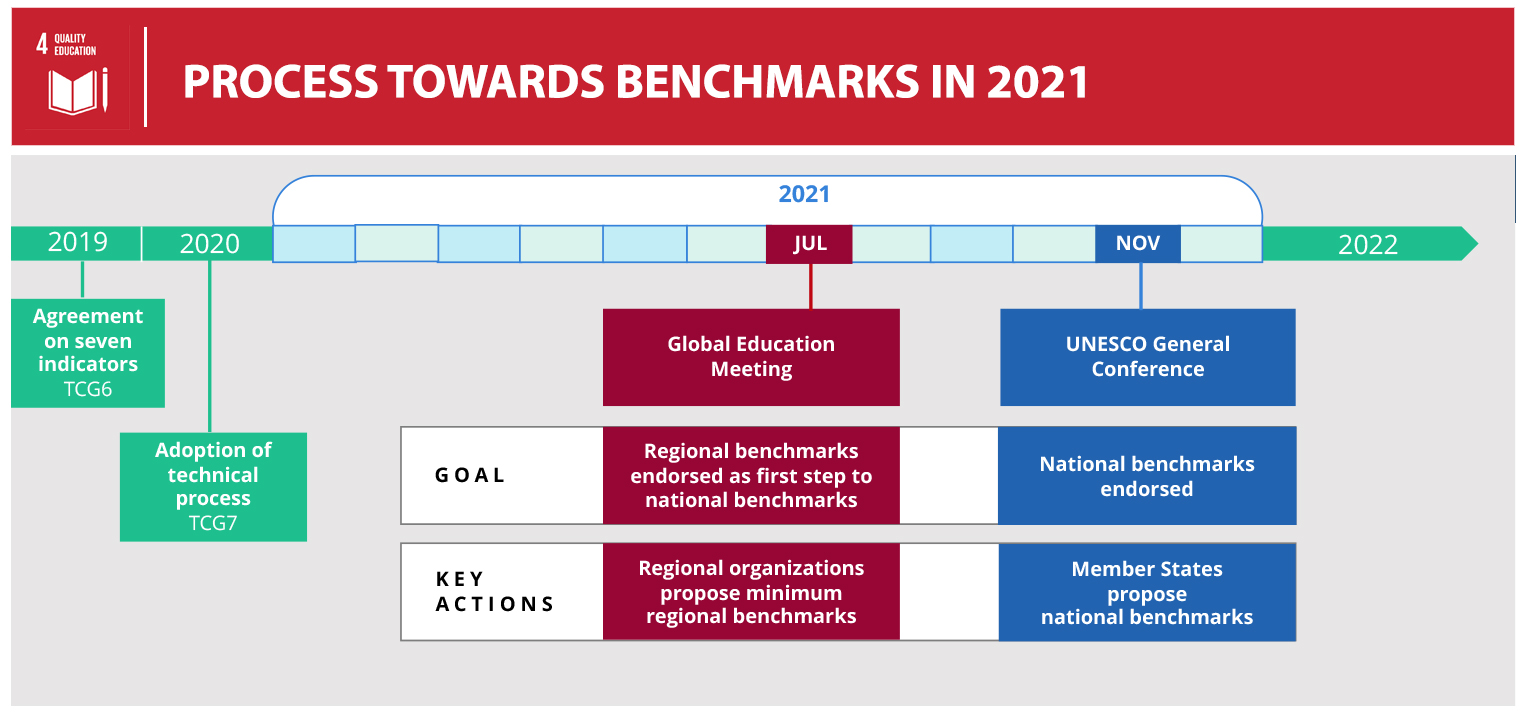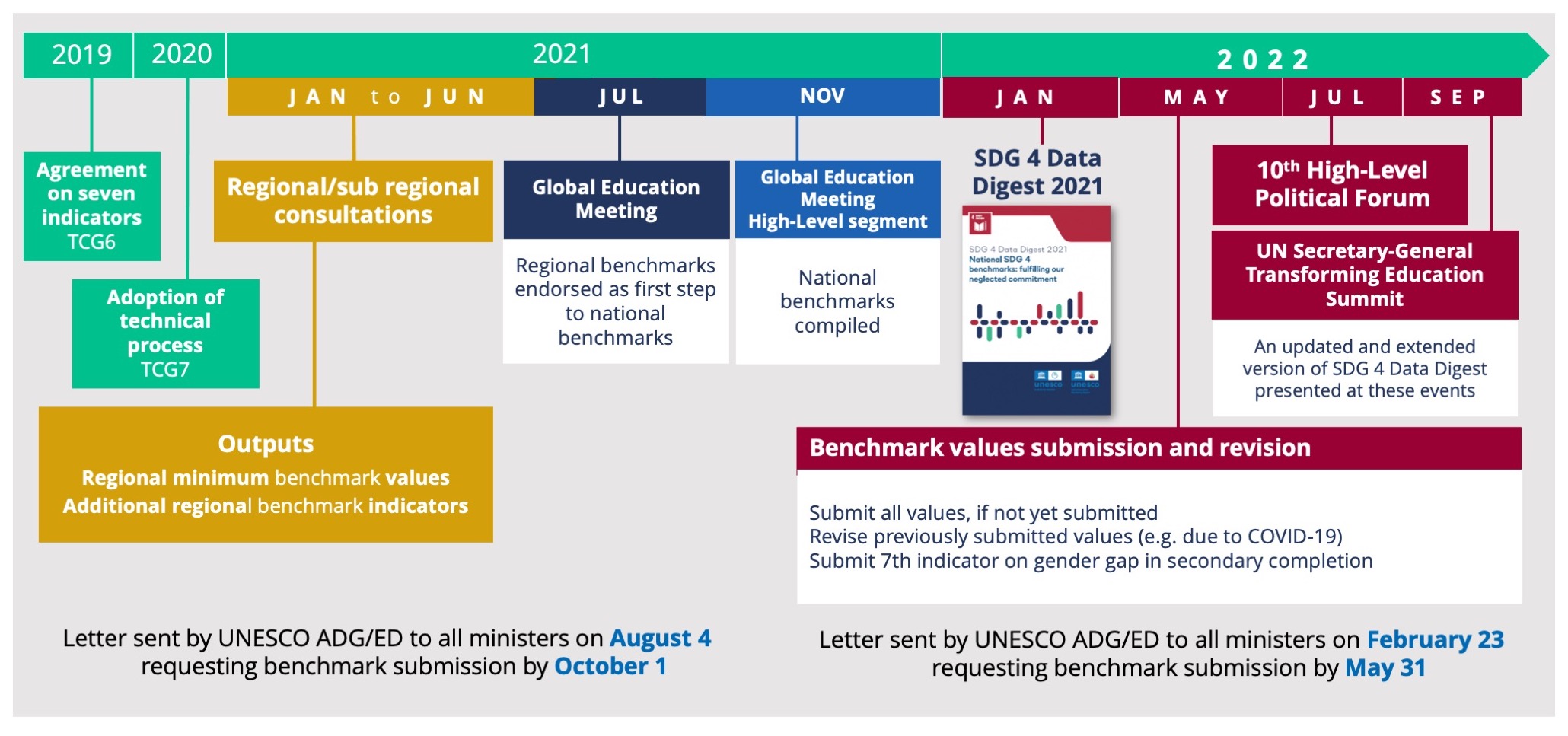SDG4 Benchmarks
Background
The Education 2030 Framework for Action called on countries to establish “appropriate intermediate benchmarks (e.g. for 2020 and 2025)” for the SDG indicators, seeing them as “indispensable for addressing the accountability deficit associated with longer-term targets” (§28), a request that remains unrealized. The extraordinary session Global Education Meeting in October 2020 reminded countries of this commitment. Its Declaration called on “UNESCO and its partners, together with the SDG-Education 2030 Steering Committee, to … accelerate the progress and propose relevant and realistic benchmarks of key SDG4 indicators for subsequent monitoring” (§10). Fulfilling this neglected commitment to set benchmarks would help renew emphasis on achieving SDG4. Countries have started from different points and move at different speeds. Unless there is a clearer and shared understanding of where countries started from in 2015, what minimum levels they should achieve and how fast, there is a risk that lack of progress will go unnoticed. But to be effective, benchmarks must be designed to mobilize action and communicated in a transparent and informative way.
In this context, the UIS and its partners agencies discussed the approaches and processes of the identifying and establishing benchmarks at global, regional and national level. A set of indicators to benchmark was adopted by the Technical Cooperation Group (TCG) in August 2019. The proposal was based on a review of proposals by TCG members, which concluded that it would be possible to set benchmarks for 6 of the 43 SDG4 indicators – plus the Framework for Action expenditure indicators – based on past trends, country coverage, frequency of data and policy relevance (see Table 1).
Table 1: Proposed Benchmark Indicators
| No. | Benchmark Indicators | Level |
|---|---|---|
| 1 | Indicator 4.1.1 - Minimum learning proficiency in reading and mathematics | Global |
| 2 | Indicator 4.1.2 - Completion rate | Global |
| 3 | Indicator 4.1.4 - Out-of-school rate | Thematic |
| 4 | Indicator 4.2.2 - Participation rate one year before primary | Global |
| 5 | Indicator 4.c.1 - Percentage of trained teachers | Global |
| 6 | Indicator Education expenditure as share of budget and GDP | Education2030 Framework for Action |
| 7 | Indicator Equity (to be defined) | Global |
UNESCO Institute of Statistics’ proposed approach
The effectiveness of benchmarking SDG4 rests primarily on two factors.
First, political commitment is needed. Setting benchmarks as requested by the Framework for Action cannot be done at global level, given the very large differences in starting points between countries. Benchmarks need to be feasible, reflecting countries’ realities but also be owned nationally. A global process that ignores countries’ own starting points, contexts or aspirations may undermine the effectiveness of benchmarking. Defining benchmarks regionally offers a balance between globally and nationally defined benchmarks, particularly when countries in a region share many of the same challenges, and a regional approach in conjunction with a national benchmark setting process enables engagement across countries to better understand common challenges and opportunities and to learn from each other.
Second, technical challenges of measurement need to be overcome.
UNESCO INSTITUTE OF STATISTICS has developed a proposed approach to benchmarking SDG4 to help guide regional entities and national governments in setting SDG4 benchmarks.
The proposed benchmarking approach establishes interim regional and national benchmarks for 2025 and 2030 that balance meaningful progress with what is feasible based on historical trends. Interim national benchmarks are based on three reference points for 2025 and 2030 for each indicator: (1) a country-specific minimum benchmark, (2) a region-specific minimum benchmark, and (3) a country-specific projection.
Timeline

Process towards benchmarks





